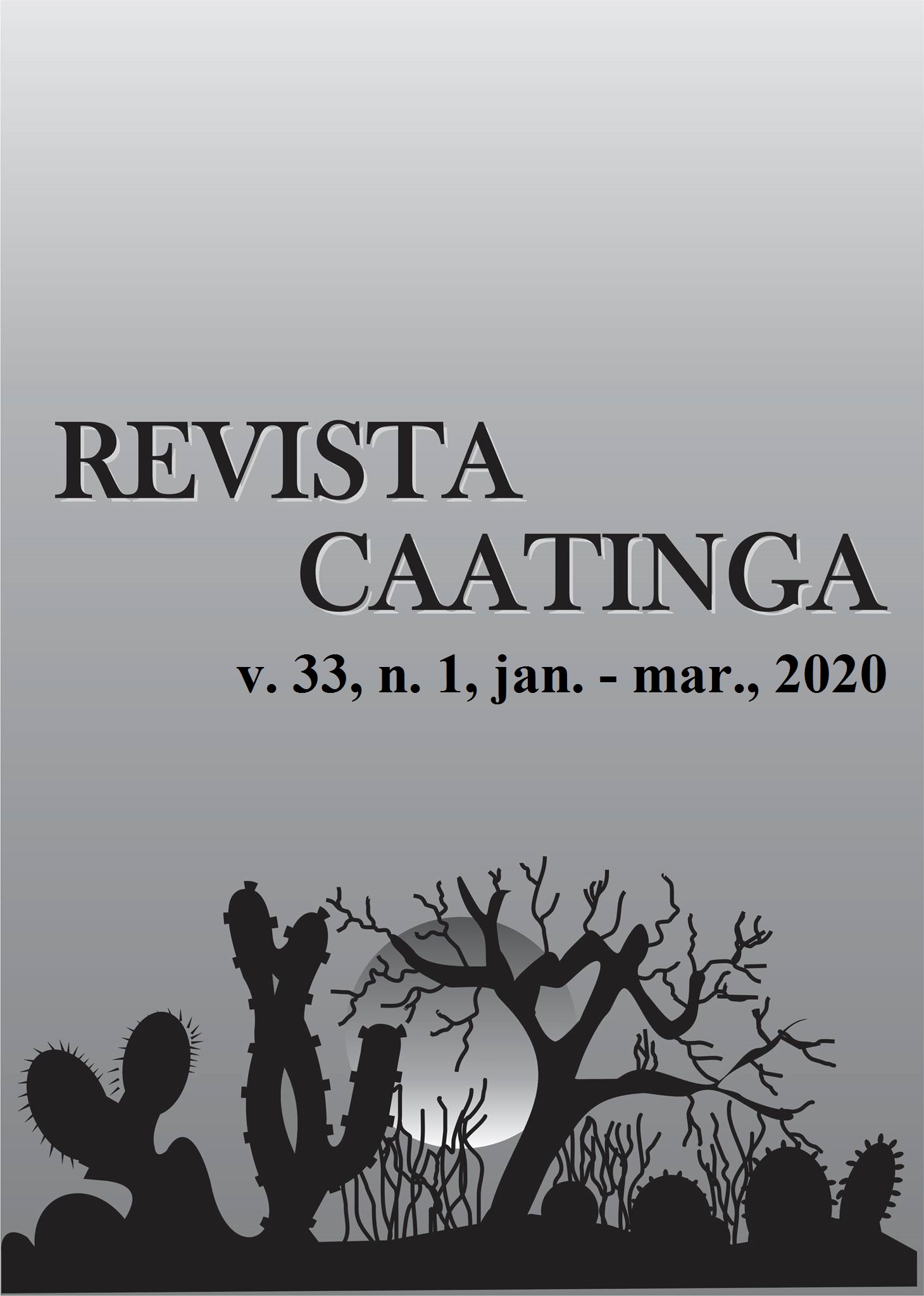APLICAÇÃO DE FILMES BIODEGRADÁVEIS EM GOIABA PARA CONTROLE DE MOSCA-DAS-FRUTAS
DOI:
https://doi.org/10.1590/1983-21252020v33n107rcPalavras-chave:
Psidium guajava. Ceratitis capitata. Recobrimento biodegradável. Temperaturas.Resumo
Psidium guajava L. é amplamente cultivada nas diversas regiões tropicais e subtropicais do mundo. Esta pesquisa teve como objetivo avaliar o efeito do uso de recobrimento biodegradável associada a diferentes temperaturas no controle e qualidade de frutos da goiabeira ‘Paluma’ infestados por Ceratitis capitata Wiedemann. O experimento foi conduzido em delineamento inteiramente casualizado em esquema fatorial 3 × 6 × 6 com três repetições. Os fatores em estudo foram três temperaturas 10 °C, 15 °C e 23 ºC (temperatura ambiente) com seis tratamentos cada: Controle – SO SR (sem oviposição e sem recobrimento); CO SR (com oviposição e sem recobrimento); SO+RCOE (sem oviposição e recobrimento contendo óleo de erva-doce); CO+RCOE (com oviposição e recobrimento contendo óleo de erva-doce); SO+RCOM (sem oviposição e recobrimento contendo óleo de manjericão) e CO+RCOM (com oviposição e recobrimento contendo óleo de manjericão). Os tratamentos foram avaliados em seis períodos conforme os fatores já mencionados. Foram realizadas avaliações físicas, físico-químicas, bioquímicas e avaliações subjetivas. Os dados foram submetidos à análise de variância com base na significância do teste F e, para testar o efeito dos dias de armazenamento, os resultados foram submetidos à análise de regressão. O uso de recobrimento biodegradável associado a temperaturas baixas minimizar a perda de massa e promove menor perda de firmeza dos frutos. A presença de larvas de C. capitata deprecia a qualidade físico-química dos frutos de goiaba, entretanto o processo de recobrimento associado a temperaturas baixas é letal a ovos e larvas de C. capitata, reduzindo os danos em frutos infestados.
Downloads
Referências
ABREU, J. R. et al. Histochemistry and morphoanatomy study on guava fruit during ripening. Ciência e Tecnologia de Alimentos, 32: 179-186, 2012.
ALMEIDA, D. M. Biofilme de blenda de fécula de batata e celulose bacteriana na conservação de fruta minimamente processada. 2010. 283 f. Tese (Doutorado em Processos Biotecnológicos: Área de Concentração em Agroindústria) – Universidade Federal do Paraná, Curitiba, 2010.
ALMEIDA, D. P. F.; HUBER, D. J. Transient increase in locular pressure and occlusion of endocarpic apertures in ripening tomato fruit. Journal Plant Physiology, 158: 199-203, 2001.
AZEVEDO, F. R. et al. Análise faunística e flutuação populacional de moscas-das-frutas (Diptera: Tephritidae) em pomares comerciais de goiaba na região do Cariri Cearense. Arquivos do Instituto Biológico, 77: 33-41, 2010.
AZEVEDO, F. R. Efeito do ensacamento sobre a incidência de moscas-das-frutas e na qualidade das goiabas. Arquivos do Instituto Biológico, 83: 1-8, 2016.
CARVALHO, R. S. Biofilme edível de amido de mandioca e refrigeração em goiaba cv. “Paluma” reduzem danos da mosca-do-mediterrâneo. In: CONGRESSO BRASILEIRO DE FRUTICULTURA, 21., 2010, Natal. Anais… Natal: EMPARN, UFERSA, Embrapa Tabuleiros Costeiros, 2010.
CENTENO, N.; MALDONADO, M.; OLIVA, A. Seasonal patterns of arthropods occurring on sheltered and unsheltered pig carcasses in Buenos Aires Province (Argentina). Forensic Science International, 126: 63-70, 2002.
CHITARRA, M. I. F.; CHITARRA, A. B. Pós-colheita de frutas e hortaliças: fisiologia e manuseio. 2. ed. Lavras, MG: Rev. e Ampl., 2005. 783 p.
HENRIQUE, C. M.; CEREDA, M. P.; SARMENTO, S. B. S. Características físicas de filmes biodegradáveis produzidos a partir de amidos modificados de mandioca. Ciência e Tecnologia de Alimentos, 28: 231-240, 2008.
HIGBY, W. K. A simplified method for determination of some aspects of the carotenoid distribution in natural and carotene-fortified orange juice. Journal of Food Science, 27: 42-49, 1962.
JACOMINO, A. P. et al. Conservação de goiabas tratadas com emulsões de cera de carnaúba. Revista Brasileira de Fruticultura, 25: 401-405, 2003.
KECHICHIAN, V. et al. Natural antimicrobial ingredients incorporated in biodegradable films based on cassava starch. Food Science and Technology, 43: 1088-1094, 2010.
KESTER, J. J.; FENNEMA, O. R. Edible films and coatings: a review. Food Technology, 40: 47-59, 1986.
LIMA, A. M. et al. New edible coatings composed of galactomannans and collagen blends to improve the postharvest quality of fruits – influence on fruits gas transfer rate. Journal of Food Engineering, 97: 101-109, 2010.
SANTOS, A. F. Desenvolvimento e maturação de abacaxi e processamento mínimo de infrutescências colhidas sob boas práticas agrícolas e tratadas com 1-MCP. 2006. 224 f. Tese (Doutorado em Agronomia: Área de Concentração em Agricultura Tropical) – Universidade Federal da Paraíba, Areia, 2006.
SANTOS, M. S. et al. Análise faunística e flutuação populacional de moscas-das-frutas (Diptera: Tephritidae) em Belmonte, Bahia. Revista Caatinga, 24: 86-93, 2011.
SAS INSTITUTE. SAS user’s guide: statistics. Software version 9.3. Cary, NC, USA, 2011.
SIQUEIRA, A. P. O. Uso de coberturas comestíveis na conservação pós-colheita de goiaba e maracujá-azedo. 2012. 91 f. Dissertação (Mestrado em Produção Vegetal: Área de Concentração em Produção Vegetal) – Universidade Estadual do Norte Fluminense Darcy Ribeiro, Rio de Janeiro, 2012.
TOIVONEN, P. M. A.; BRUMMELL, D. A. Biochemical bases of appearance and texture changes in fresh-cut fruit and vegetables. Postharvest Biology and Technology, 48: 1–14, 2008.
ZENEBON, O.; PASCUET, N. S.; TIGLEA, P. Métodos físico-químicos para análise de alimentos. 4. ed. São Paulo: SP, Instituto Adolfo Lutz, 2008. 1020 p.
Downloads
Publicado
Edição
Seção
Licença
Os Autores que publicam na Revista Caatinga concordam com os seguintes termos:
a) Os Autores mantêm os direitos autorais e concedem à revista o direito de primeira publicação, com o trabalho simultaneamente licenciado sob a Licença Creative Commons do tipo atribuição CC-BY, para todo o conteúdo do periódico, exceto onde estiver identificado, que permite o compartilhamento do trabalho com reconhecimento da autoria e publicação inicial nesta revista, sem fins comerciais.
b) Os Autores têm autorização para distribuição não-exclusiva da versão do trabalho publicada nesta revista (ex.: publicar em repositório institucional ou como capítulo de livro), com reconhecimento de autoria e publicação inicial nesta revista.
c) Os Autores têm permissão e são estimulados a publicar e distribuir seu trabalho online (ex.: em repositórios institucionais ou na sua página pessoal) a qualquer ponto antes ou durante o processo editorial, já que isso pode gerar alterações produtivas, bem como aumentar o impacto e a citação do trabalho publicado (Veja O Efeito do Acesso Livre).







